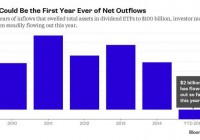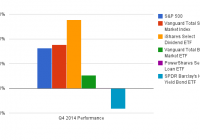Summary The tepid return in the major averages was generated by weakening in interest rate sensitive areas and continued strength in high growth leadership categories. Healthcare stocks were once considered a defensive area of the market, yet have transitioned to a more growth oriented phase. Conversely, utility stocks have been torched by rising interest rates that have eaten away at their returns. The S&P 500 Index was nearly unchanged in the first half of 2015, yet the divergences in underlying sectors told a very different tale. The tepid return in the major averages was generated by weakening in interest rate sensitive areas and continued strength in high-growth leadership categories. This tug-of-war style market has created a relative valuation chasm between several important sectors that warrants close attention. Leader: Healthcare Healthcare stocks were once considered a defensive area of the market similar to consumer staples and utilities because of their inelastic business models. After all, medical services and drug companies operate with little cyclical burden to their bottom line. Nevertheless, some believe that these stocks have transitioned to a more growth-oriented phase that has been driven by the biotech boom and continued advancements in the medical field. The Health Care Select Sector SDPR ETF (NYSEARCA: XLV ) has been a top performing area of the market over the last three- and five-year time frames and continues to lead as the No. 1 sector so far this year. There’s no doubt that this ETF has shown tremendous momentum and activity has been robust as XLV has gained 9.51% through June 30. While this area of the market has been one of the most resilient, I would be hesitant to chase performance and add near its recent highs. If XLV or a similar healthcare fund has been on your radar, I would be patient with respect to any future entry points and look to pick up shares on at least a modest dip. In addition, this sector should serve as a benchmark of momentum leadership. If we see XLV start to fall out of favor, it may signal that investors are looking to pair back on risk and potentially rotate into a more defensive stance. Healthcare stocks currently make up over 30% of the iShares MSCI USA Momentum Factor ETF (NYSEARCA: MTUM ), which screens its underlying holdings for recent performance characteristics. Laggard: Utilities On the flip side of the coin, utilities have been torched this year as a result of rising interest rates. Coming off a strong performance in 2014 where rising rates acted as a tailwind, the Utility Select Sector SPDR (NYSEARCA: XLU ) is down 10.70% through the first half of 2015. The price of XLU peaked at virtually the same time as interest rates bottomed and has been on a steady course lower ever since. For the moment, it appears that the fate of utility stocks is going to be closely tied to the price action of U.S. Treasury yields. This traditionally defensive sector has been eschewed for more growth-oriented positions in healthcare, consumer discretionary and technology stocks. From a relative value standpoint, I believe that utilities look attractive at these levels given the thesis that interest rates will remain stable or head lower over the next six months. The recent drop in price also has boosted the yield on XLU to a healthy 3.80%, which makes it the highest yielding sector in the S&P 500. Income investors should note that diversified dividend funds such as the iShares Select Dividend ETF (NYSEARCA: DVY ) and First Trust Morningstar Dividend Leaders Index Fund (NYSEARCA: FDL ) have outsized utility sector exposure. This asset allocation acted as a drag on returns in the first half of the year and should be noted as a key driver moving forward as well. Tweener: Financials Financial stocks have long been touted as the cure to beat rising interest rates, yet the Financial Select Sector SPDR (NYSEARCA: XLF ) has been mired in a sideways malaise since the beginning of the year. XLF posted a net return of -0.61% through the first six months of 2015 and has failed to show inspiring price action to back up its reputation. XLF is an interesting fund because of the wide designation of financial-centric companies. This ETF includes large banks, REITs, brokerages and even diversified holding companies such as Berkshire Hathaway Inc (NYSE: BRK.A ) (NYSE: BRK.B ). REITs are currently the third largest industry group within XLF at 14.20% and have dragged on returns since the beginning of the year. The iShares U.S. Real Estate ETF (NYSEARCA: IYR ) has experienced the same interest rate sensitive drag as utility stocks and is down 5.5% in 2015. Conversely, indexes that focus solely on banking stocks such as the SPDR S&P Bank ETF (NYSEARCA: KBE ) have gained 8.87% this year. Clearly these stocks are the true beneficiaries of the rising interest rate theme as it relates to a fundamental driver of industry returns. Ultimately, XLF appears to be experiencing its own internal tug-of-war based on this bifurcation between sub-sectors that has caused it to drift aimlessly for the last six months. The Bottom Line The information presented above can be applicable to both broad-based indices and individual sector investing. Investors that own diversified equity ETFs need to be cognizant of the underlying asset allocation and sector positioning as it relates to future risk and returns. Those who prefer to select more targeted ETFs may choose to shift their positions in order to take advantage of a specific theme or pair back on an overbought area of the market. Making small tactical changes of this nature can have a big impact on your performance and risk profile as we make our way into the second half of the year. I spoke in-depth about these topics and more in our recent mid-year teleseminar: Four Components Of A Successful Income Portfolio . Click here for the presentation . Disclosure: I am/we are long DVY. (More…) I wrote this article myself, and it expresses my own opinions. I am not receiving compensation for it. I have no business relationship with any company whose stock is mentioned in this article. Additional disclosure: David Fabian, FMD Capital Management, and/or clients may hold positions in the ETFs and mutual funds mentioned above. The commentary does not constitute individualized investment advice. The opinions offered herein are not personalized recommendations to buy, sell, or hold securities.

